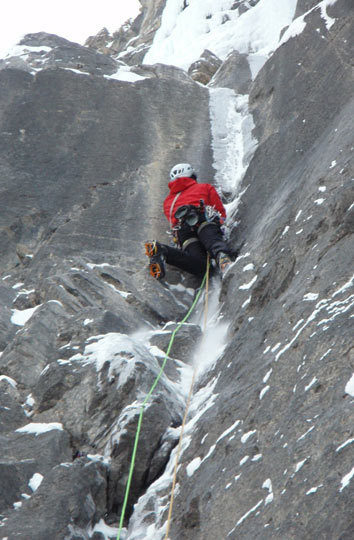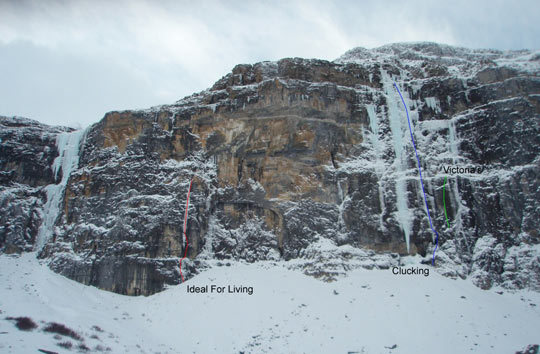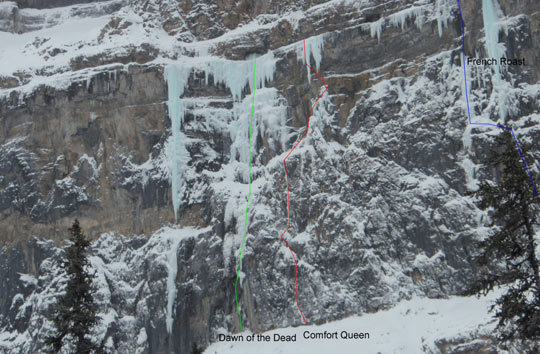
Slawinski stems up Extreme Comfort (5.11 R WI6+ A3, 180m, Anker-Backes-Josephson, 1995) two weeks before linking that climb with Drama Queen to create Comfort Queen (M6 R WI6, 180m), one of five boltless new mixed climbs he established this winter on the Stanley Headwall, Alberta, Canadian Rockies. [Photo] Ian Welsted
Editor’s Note: This report provides a brief history of mixed climbing on the Stanley Headwall in the Canadian Rockies, then documents Slawinski’s substantial development there this season. His five first ascents this winter constitute some of the most concentrated new-routing in the Headwall’s history. Remarkably, for an area that many thought climbed out, they were accomplished without placing any bolts.
The Stanley Headwall (or simply, THE Headwall): the premier hard ice and mixed crag of the Canadian Rockies and a testing ground for winter climbing since 1974. That was the year when Bugs McKeith spearheaded the first ascent of Nemesis (WI6, 150m), brandishing Terrordactyls, aiders, fixed ropes and all. Six years later James (“If you hang on your umbilicals I’m gonna tell your Ma!”) Blench, John Laughlan and Albi Sole made the second ascent and the first free ascent of the climb. However, their effort did little to dispel the Headwall’s intimidating aura. It was not until the early 1990s that the other blindingly obvious ice lines began to be picked off: French Reality (WI6+, 150m), Acid Howl (WI6+, 300m) and others. It was around this time that people began to approach ice with the attitude that “it doesn’t have to be formed to be formed.” Jeff Everett and Glenn Reisenhofer were the first to apply this new vision to the Headwall in 1991 when they hand-drilled their way to the hanging dagger of Suffer Machine (WI5 A2, 200m). Three years later Francois Damilano and Joe Josephson upped the ante on The Day After Les Vacances de Mr. Hulot (WI6 5.9 A2, 270m), a sustained melange of traditional mixed, aid and ice climbing. In 1997 Matt Collins and I made the second ascent and the first free ascent of Mr. Hulot, onsighting the aid pitches at M7 in a classic display of beginners’ luck.
The same year, 1997, marked the beginning of a new chapter in the history of the Headwall. Sean Isaac and Dave Thomson imported the weird and wonderful concept of bolt-protected mixed climbing from the crags of Colorado to the grand arena of the winter Rockies. Armed with a new vision and a power drill, the two more than doubled the number of routes on the Headwall. Some of their efforts were direct starts to existing routes (e.g. Teddy Bear’s Picnic [M8] to Suffer Machine). Others were largely or completely independent lines (e.g. Nightmare on Wolf Street [M7+ WI6+, 170m], one of the finest routes in the entire Rockies). For a period of time the Headwall even went through a single-pitch phase, with a flurry of routes developed in the Thriller cave. Every time I went up there, passing soaring limestone walls streaked with ice only to bury myself in a chossy hole with bolts in the ceiling, I was vaguely aware of the perverseness of what I was doing. At the time, though, it made perfect sense. However, after a few seasons of unquestioning enthusiasm, I began to see bolt-protected mixed climbing in a different light. The big moves and inverted gymnastics on bolted routes were a lot of fun, but they also gave one the strength and skill to venture into steep terrain with no bolts in sight. The lessons I learned in the cave served me well elsewhere in the Rockies. However, it was not until this winter that I came back to apply them to the Headwall.

The Nemesis area of the Stanley Headwall, showing a handful of Slawinski’s new routes: An Ideal For Living (M6 WI5 X, 100m), Clucking (M6 WI5, 200m) and Victoria’s Secret Deviation (M7+, 50m). All were established with natural pro. [Photo] Raphael Slawinski
In late October of 2007, Eamonn Walsh and I headed up the Stanley Glacier trail for our first taste of ice of the season. Located past the Headwall proper, Ice Cannibal is a long rambling route below a mostly benign serac barrier. As neither of us had climbed it before, we were pleased with our outing. “Well, here’s my obligatory day on the Headwall for this season out of the way,” I thought to myself as we walked down the trail. But less than a month later I was back, enticed by news of some rarely formed routes being in. A week earlier a friend had lost his life in the mountains: I was sad, angry and confused. I looked to climbing to clear my mind.
Originally Eamonn and I were intent on Uniform Queen (WI5, 170m). But when I saw the route, first ascended at M7, I turned to my partner: “I can’t climb that, there’s too much ice on it.” Instead we turned our attention to a thin smear between Uniform Queen and Suffer Machine. A few steep moves past a nest of pins and cams, feet pasted under a roof, gained the ice goatee. After another two pitches our line merged with the blue ice of Suffer Machine. For lack of a better name we called it Clucking (M6 WI5, 200m); an Internet search will reveal the genesis of the name.
The following day I was back with Scott Semple, this time bound for a discontinuous smear between Suffer Machine and Nemesis. I had my doubts about whether it would go on natural gear, but in the end the bolt kit stayed on my harness. To begin with, gear placements appeared when needed; and, when they failed to materialize, we gently tapped our way up without such comforts. Like the reasons for climbing, the reasons for the name were ambiguous: An Ideal For Living (M6 WI5 X, 100m). Looking back, I think that was where the inspiration for exploring the possibilities for traditional mixed climbing on the Headwall came from.
Ian Welsted knew that over the years I had worked my way through most of the routes on the Headwall. As we cast about for something to do on a weekend in December, he considerately suggested something appropriately obscure. Conrad Anker, Scott Backes and Joe Josephson had climbed Extreme Comfort (5.11 R WI6+ A3, 180m) in 1995 to access the spectacular pillar now more commonly climbed as part of Nightmare on Wolf Street. However, our interest was piqued by the guidebook description of the first pitch and the leader hanging from a hook to put his crampons on. Luckily we did not have to resort to such tactics. Instead, a vein of snice in the back of a corner offered excellent mixed climbing and gear. Running out of time, we finished up the upper ice of Mr. Hulot.
But two weeks later we were back, enticed by a ribbon of what looked like ice above the initial corner. While snice in a corner makes for good climbing, snice on a bulging wall makes for scary climbing. Finding no gear above a stretch of snice climbing I was not keen to reverse, and with the bolt kit back in my basement, I had no choice but to continue into the unknown. We finished up Drama Queen, clipping bolts and swinging onto a wild hanging dagger by headlamp. We called our link-up Comfort Queen (M6 R WI6, 180m), deeming the other possible combination of names too melodramatic.

Slawinski leading through Victoria’s Secret Deviation (M7+, 50m), “a sinuous crack splitting the clean vertical wall” left of Uniform Queen. [Photo] Wiktor Skupinski
It was Christmas, and I was just getting over a cold. In other words, a mellow day seemed in order. That was how, in spite of the route sporting excessive amounts of ice, I ended up ticking Uniform Queen. However, while climbing the crux middle pitch, I was constantly distracted by a sinuous crack splitting the clean vertical wall to the left. I had just read about the hard new route The Secret on Ben Nevis (read the December 12, 2007 NewsWire for more); could this be the Rockies’ version? One thing was clear: I wanted to try the line onsight, using only natural gear. In the end the onsight attempt came to naught, as a combination of pump, thin ice, spindrift and frozen hands sent me for three increasingly long whippers. I had to be satisfied with coming back the next day and redpointing the line. But I did succeed in my other goal: puzzling out the climbing and the protection from the ground up. Given that the inspiration came from across the pond, Victoria’s Secret Deviation (M7+, 50m) seemed like an appropriate name.
By now I was full of self-righteous zeal for traditional mixed climbing, but I could not think of another new line like Victoria’s. Instead, a few weekends later, I headed for Dawn of the Dead (M8 WI6, 150m). The route, essentially a direct start to the upper ice of Mr. Hulot, had been established using a mix of bolts and gear. Could one do it without clipping any of the bolts? The initial crack went well enough. It was on the discontinuous splatters of ice higher up, with the last gear hidden below a big roof, that my determination was put to the test. However, by now I was climbing in a separate reality, the bolts I was bypassing all but invisible to me as I nested together a cam, a pin and a wire. My perversion reached its apex on the way down as hanging next to a bolted station I equalized two abalakovs in thin ice. Steve Swenson, my long-suffering partner, could only shake his head.
Do not misunderstand me: I love sport climbing in both its summer and winter incarnations. Bolts can open up fantastic terrain, allowing us to play with gravity on big overhangs and big daggers. However, bolts should add to the adventure, not diminish it. If a line looks even remotely feasible without bolts, then before reaching for the gun we owe it to ourselves simply to walk up to it and start climbing.
The beginning of February found me yet again on the Headwall. Jon Walsh and I both had been eying the daggers above French Toast (M7 WI5, 130m), and we teamed up to explore them. A few weeks earlier I had backed off the glaze of ice on the first pitch of the original route when the bolts ran out. Instead, we climbed the mixed chimney on French Reality and traversed into French Toast on a narrow snow ledge. Above the final pillar of that route an ice-filled crack split a bulge. Another pitch up a thinly iced overhanging corner took us to the end of the difficulties. As we rappelled our French Roast variation, I sadly realized that I had nothing left to do on the Headwall. Then again, that was what I had thought back in October.

The Mr. Hulot area of the Stanley Headwall. Slawinski climbed his link-up Comfort Queen (M6 R WI6, 180m), then later in the season bypassed all the bolts on the previously established Dawn of the Dead (M8 WI6, 150m). To top it off, in early February he and Jon Walsh climbed the mixed chimney on French Reality then traversed into French Toast for a new combination, French Roast, which involved 50 meters of new terrain at M6. [Photo] Raphael Slawinski